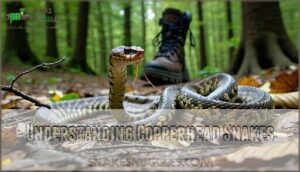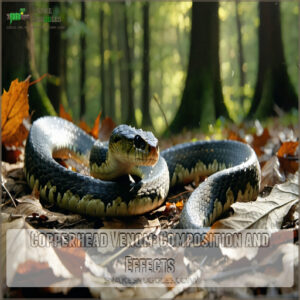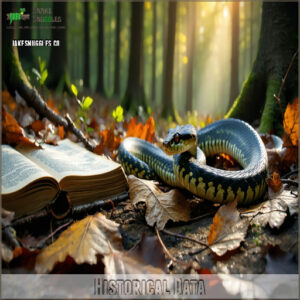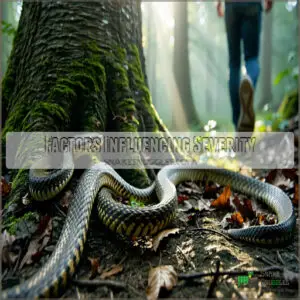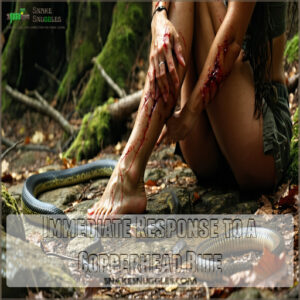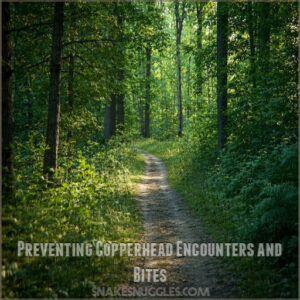This site is supported by our readers. We may earn a commission, at no cost to you, if you purchase through links.
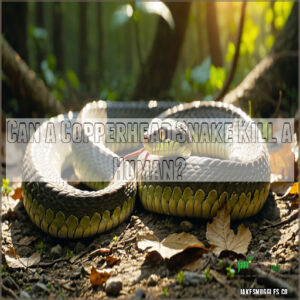 A copperhead snake bite is rarely fatal to humans, with a mortality rate of less than 0.01%. While their venom contains hemotoxins that cause pain, swelling, and tissue damage, it’s typically not potent enough to kill a healthy adult.
A copperhead snake bite is rarely fatal to humans, with a mortality rate of less than 0.01%. While their venom contains hemotoxins that cause pain, swelling, and tissue damage, it’s typically not potent enough to kill a healthy adult.
However, bites can still be serious, especially for children, the elderly, or those with health issues. Immediate medical attention is essential to manage symptoms and prevent complications.
Think of it this way: you’re statistically more likely to get struck by lightning than to die from a copperhead bite. Still, staying snake-aware can save you a world of pain—literally and figuratively, which is a practical consideration, and helps prevent serious complications.
Table Of Contents
- Key Takeaways
- Can a Copperhead Snake Kill a Human?
- Understanding Copperhead Snakes
- Copperhead Venom: Composition and Effects
- Likelihood of Fatal Copperhead Bites
- Immediate Response to a Copperhead Bite
- Medical Treatment for Copperhead Bites
- Long-Term Effects and Recovery
- Preventing Copperhead Encounters and Bites
- Frequently Asked Questions (FAQs)
- Is a copperhead snake venomous?
- Why is hydrocephalus more harmful in adults?
- Does Copperhead venom kill humans?
- Do copperhead snakes eat humans?
- Can a copperhead bite kill you?
- Do copperhead snakes bite?
- How Far Away Should You Stay From a Copperhead Snake?
- What Are the Long-term Effects of a Copperhead Snake Bite?
- Are There Any Differences Between Male and Female Copperhead Snakes?
- Are Copperhead Snakes More Active During the Day or Night?
- Conclusion
Key Takeaways
- Copperhead snake bites are rarely fatal to humans, with a mortality rate of less than 0.01%, but immediate medical attention is still essential.
- Their venom causes painful symptoms like swelling, tissue damage, and bruising but is generally mild compared to other venomous snakes.
- Most bites happen when humans accidentally step on or provoke them, so staying aware of your surroundings can help you avoid encounters.
- Long-term effects like nerve damage or chronic pain are uncommon if you seek treatment quickly and manage the bite properly.
Can a Copperhead Snake Kill a Human?
While copperhead snakes can deliver a venomous bite, their reputation is far worse than their actual threat to human life. The mortality rate from copperhead snake bites is remarkably low—less than 0.01% of cases result in death. You’re statistically more likely to be struck by lightning than suffer a fatal copperhead attack.
However, don’t let these statistics make you complacent about human safety. Their venom can cause significant tissue damage and severe pain, requiring immediate medical attention.
The key to avoiding a bite lies in understanding copperhead habitat and practicing proper bite prevention techniques. Remember: while these snakes aren’t typically lethal to humans, their bites demand serious medical care and respect.
Understanding Copperhead Snakes
You’ll find copperhead snakes throughout the eastern and central United States, where they display distinctive copper-colored heads and hourglass-shaped patterns on their bodies.
As members of the pit viper family, they’re equipped with heat-sensing pits between their eyes and nostrils, allowing them to detect warm-blooded prey with remarkable precision.
Physical Characteristics
When identifying these remarkable pit vipers, you’ll notice their striking copper-red heads and distinctive hourglass patterns along their bodies.
Copperheads typically inhabit forests and rocky areas.
Here are key physical markers:
- Body measures 2-3 feet in length, with newborns at 7-9 inches
- Triangular head houses heat-sensing pits between eyes and nostrils
- Scales display rich copper tones with darker crossbands
- Elliptical pupils distinguish them from non-venomous species
- Muscular frame maintains a moderate girth throughout
Their unique scale coloration serves as nature’s warning sign, helping you spot these venomous snakes in their eastern and central US habitats.
Habitat and Behavior
Beyond their distinctive copper-colored heads, these remarkable snakes adapt to diverse environments across the eastern and central United States.
You’ll find them in rocky outcrops, forest edges, and even suburban areas.
While venomous, they’re surprisingly shy and prefer to avoid human contact.
Their excellent camouflage helps them blend perfectly with fallen leaves and pine straw, making habitat awareness essential for your safety.
Copperhead Venom: Composition and Effects
You’ll find that copperhead venom contains hemotoxins that break down blood cells and damage tissue at the bite site.
While their venom is less potent than other pit vipers, you’ll experience symptoms like severe pain, swelling, and bruising if bitten.
Venom Potency
Regarding venom strength, you’ll find that copperhead snake venom isn’t typically lethal to humans.
Their hemotoxic venom primarily targets blood cells and tissue, causing localized damage rather than systemic failure.
While the toxic levels can vary, the mortality rate remains remarkably low.
Bites are rarely fatal, but copperhead bite complications can arise.
The bite severity depends on factors like venom dosage and location, but modern antivenom treatments have made fatal outcomes extremely rare, with a focus on systemic failure being a key consideration.
Symptoms of Envenomation
While copperhead venom isn’t typically lethal, its effects can be quite distressing. After a bite, you’ll experience immediate tissue damage and intense pain at the wound site, followed by rapid swelling and discoloration.
Within hours, systemic reactions may develop, including nausea, dizziness, and difficulty breathing. Local symptoms often include bruising, blistering, and in some cases, tissue necrosis that requires careful wound care and pain management.
Understanding the role of copperhead snake venom is essential for effective treatment and management of envenomation.
- Your body’s response to copperhead venom can feel like an intense burning sensation radiating from the bite site – imagine touching a hot stove, but the sensation doesn’t fade quickly.
Remember, proper medical attention is necessary for monitoring both local and systemic symptoms.
Likelihood of Fatal Copperhead Bites
You’ll be relieved to know that copperhead bites rarely result in human fatalities, with less than 0.01% of cases proving lethal.
While their venom can cause significant pain and tissue damage, you’re far more likely to encounter one of the approximately 2,920 non-fatal copperhead bites that occur annually in the United States.
Historical Data
Five documented fatalities from copperhead snakes occurred between 1989 and 2018, representing a small fraction of the 101 fatal native snake bites in the United States.
During this period, bite trends showed that males faced higher risks, with a median victim age of 40.
Venom studies reveal that most fatal snake attacks happened during intentional interactions, such as religious services or attempts to handle or kill the snake.
Understanding copperhead snake care is essential in preventing and treating snake bites effectively, which often require intentional interactions and involve religious services.
Factors Influencing Severity
While copperhead snake bite death is rare, several key factors determine the severity of your encounter.
Bite location matters substantially – venom spreads faster when injected closer to your heart.
Your age and overall health play vital roles too, as children and elderly individuals face higher risks.
Snake size and environmental factors, like temperature, can affect venom potency.
- Picture a tiny toddler’s ankle swelling rapidly after an unexpected garden encounter
- Imagine an elderly hiker’s hand turning purple within minutes of moving a log
- Visualize the difference between a small defensive bite versus a full venom injection to understand the severity of a snake bite.
Immediate Response to a Copperhead Bite
You’ll need to act quickly if you’ve been bitten by a copperhead snake, as proper first aid can substantially reduce tissue damage and complications.
While you’re waiting for medical help to arrive, you can take several immediate steps to improve your outcome.
Including keeping the bitten area below heart level and removing any tight clothing or jewelry is crucial for a better outcome.
First Aid Measures
While fatalities from copperhead bites are rare, knowing proper first aid measures can substantially improve outcomes. When a copperhead snake bite occurs, your immediate actions matter.
Start by keeping movement minimal to slow venom spread. Here’s what you need to do:
| Action | Time Frame | Key Points |
|---|---|---|
| Clean Wound | First 2-3 minutes | Use soap and water, no antiseptics |
| Remove Restrictive Items | Next 1-2 minutes | Take off rings, watches, tight clothing |
| Position Bite Site | Immediately after | Keep below heart level |
Having a snake bite kit is essential for effective first aid treatment using snake bite tools. Document when the bite occurred and mark the edge of any swelling with a pen.
Call emergency services right away – every minute counts in snake bite treatment.
What Not to Do
When dealing with a copperhead snake bite, forget the old myths.
Don’t use tourniquets, ice packs, or cut and suck the wound—they can worsen the injury.
Avoid tall grass, handle snakes cautiously, and don’t touch wild snakes to stay safe.
Instead, remove tight items, keep the bite below heart level, and seek emergency care immediately to prevent complications, which is crucial for staying safe from copperhead snake bites.
Medical Treatment for Copperhead Bites
If you’re bitten by a copperhead, prompt medical attention is essential to manage symptoms and prevent complications.
Treatments like antivenom and supportive care can help reduce tissue damage and control pain effectively.
Antivenom Administration
Antivenom is an essential copperhead snake bite treatment, but it’s not always necessary.
Venom dosage, symptom severity, and timing influence its use.
Only 25% of cases need antivenom, which binds venom proteins to limit tissue damage.
Snakebite protocols prioritize medical response to assess risks.
Copperhead snake antivenom is expensive, not always available, and prescribed cautiously to avoid unnecessary complications.
The administration of effective copperhead antivenom relies on careful consideration of the patient’s condition to ensure the best possible treatment.
Supportive Care
Regarding copperhead snake bite treatment, supportive care is about keeping you comfortable and preventing complications. Beyond antivenom, doctors focus on pain management, wound care, and patient monitoring to address copperhead snake bite effects.
Here’s what’s involved:
- Monitoring symptoms like swelling and copperhead snake bite symptoms progression.
- Hydration and keeping wounds clean to avoid infection.
- Emergency response for unexpected issues, like severe reactions, facilitates safe recovery and helps to make certain that you receive proper care.
Long-Term Effects and Recovery
If you’re bitten by a copperhead, recovery can take weeks or even months, depending on the severity.
Long-term effects like lingering pain, nerve damage, or reduced mobility may require rehabilitation and medical follow-up.
Potential Complications
Severe copperhead snake bite effects, though uncommon, include tissue damage, nerve damage, and even systemic reactions like organ failure.
Infection risk from untreated bites can complicate recovery, while rare cases of copperhead snake bite infection may worsen outcomes.
The copperhead snake mortality rate remains low, but timely care prevents escalation.
Always monitor for persistent copperhead bite symptoms such as swelling or discoloration, as delayed attention increases the chances of lasting complications.
Rehabilitation Process
Recovering from a copperhead snake bite varies, but with proper care, you’ll typically heal within weeks or months.
Physical therapy can help restore strength and mobility, while medical follow-ups facilitate effective wound healing and tissue repair.
Some may need pain management or scarring treatments.
Individual sensitivity to venom influences recovery, so stick to your copperhead snake bite treatment plan.
Understanding snake skin problems treatment is essential for maintaining healthy pets, especially those with skin infection issues.
With patience and professional guidance, long-term effects are rare, despite the snake’s venomous nature and low mortality rate.
Preventing Copperhead Encounters and Bites
You can reduce your chances of encountering copperheads by understanding their habitats and taking simple precautions.
Wearing sturdy boots, keeping your yard clear of debris, and being alert in snake-prone areas all go a long way in staying safe.
Habitat Awareness
Understanding snake habitats helps you stay safe. Copperhead snakes favor woodland areas, rocky areas, and spots near water sources. Their camouflage blends perfectly with leaves and debris, especially in suburban risks zones.
To reduce encounters, maintain clean yards, clear leaves, and keep grass short. Terrain awareness in high-risk months (April-September) is key in managing copperhead snake habitat interactions and preserving forest ecology.
Effective snake control often involves using a snake repellent method to deter them from your area.
Personal Protective Measures
In terms of snake safety, a little prep goes a long way. Take these personal protective measures to avoid bites:
- Wear protective clothing, like long pants and close-toed shoes.
- Practice yard maintenance: keep grass trimmed and debris cleared.
- Use snake repellents, such as sulfur or ultrasonic devices.
- Follow safe hiking practices: stay on clear trails and avoid overgrown paths.
Understanding snake bite prevention is essential for effective protection against venomous snakes.
Frequently Asked Questions (FAQs)
Is a copperhead snake venomous?
With its hourglass-patterned body and heat-sensing pits, the copperhead is indeed venomous.
While its hemotoxic venom causes pain and swelling, it’s relatively mild and rarely life-threatening, making this snake more intimidating than deadly.
Why is hydrocephalus more harmful in adults?
Hydrocephalus is more dangerous in adults because their skulls can’t expand like a child’s.
The pressure buildup compresses brain tissue, causing severe damage or functional loss.
Prompt treatment helps reduce risks and manage symptoms effectively.
Does Copperhead venom kill humans?
A copperhead’s venom is like a bee sting on steroids—it’s rarely fatal to humans.
Their venom is mild compared to other snakes, causing pain and swelling, but fatalities are extremely rare with quick medical care.
Do copperhead snakes eat humans?
Copperhead snakes don’t eat humans—it’s biologically impossible.
They’re ambush predators targeting small prey like mice, frogs, or insects.
Their size, jaw structure, and feeding behavior guarantee humans aren’t on their menu.
So, you’re safe from these small prey hunters.
Can a copperhead bite kill you?
Regarding copperhead bites, it’s rare they’re deadly.
While their venom causes pain and tissue damage, fatalities are uncommon unless allergic reactions or delayed medical attention occur.
Quick treatment guarantees safety and recovery.
Do copperhead snakes bite?
Yes, they bite, usually when they feel threatened or accidentally stepped on.
Copperhead bites aren’t uncommon, but these snakes prefer avoiding conflict.
Staying aware of your surroundings greatly reduces the chances of an unwanted encounter.
How Far Away Should You Stay From a Copperhead Snake?
Stay at least 6 to 8 feet away from a copperhead to guarantee safety since they can strike about half their body length.
Give them space, don’t provoke them, and calmly move away to avoid confrontation.
What Are the Long-term Effects of a Copperhead Snake Bite?
A copperhead bite’s long-term effects may include scarring, nerve damage, chronic pain, or weakened tissue near the bite site.
Rarely, complications like infection or impaired mobility arise, but timely medical care substantially reduces these risks, including the risk of infection.
Are There Any Differences Between Male and Female Copperhead Snakes?
Picture a biological coin flip — male copperheads grow slightly larger, while females carry more fat reserves, essential for reproduction.
Males also roam further during mating season, increasing chances of encounters but maintaining similar venom potency.
Females, with their fat reserves, play a crucial role in the species’ survival through successful reproduction.
Are Copperhead Snakes More Active During the Day or Night?
Copperhead snakes are mostly nocturnal, becoming active at night, especially during warmer months.
They may occasionally hunt during the day in cooler weather.
You’ll likely encounter them at dusk or nighttime, so stay vigilant outdoors.
Conclusion
Just as a copperhead’s patterned scales blend into its surroundings, their bite often hides in plain sight of nature’s dangers.
While a copperhead snake can’t typically kill a healthy human, their venom still demands respect.
Quick action, like seeking medical care, guarantees minimal risk of long-term damage.
Stay alert in their habitats, wear protective gear, and don’t panic if bitten.
With proper precautions and awareness, you can coexist safely with these fascinating but venomous snakes.
- https://www.nationalgeographic.com/animals/article/copperhead-snake-bites-venom
- https://www.poison.org/articles/copperhead-snakes
- https://www.livescience.com/43641-copperhead-snake.html
- https://urbanjunglewildliferemoval.com/blog/copperhead-snake-safety/
- https://www.cdc.gov/niosh/topics/snakes/default.html

